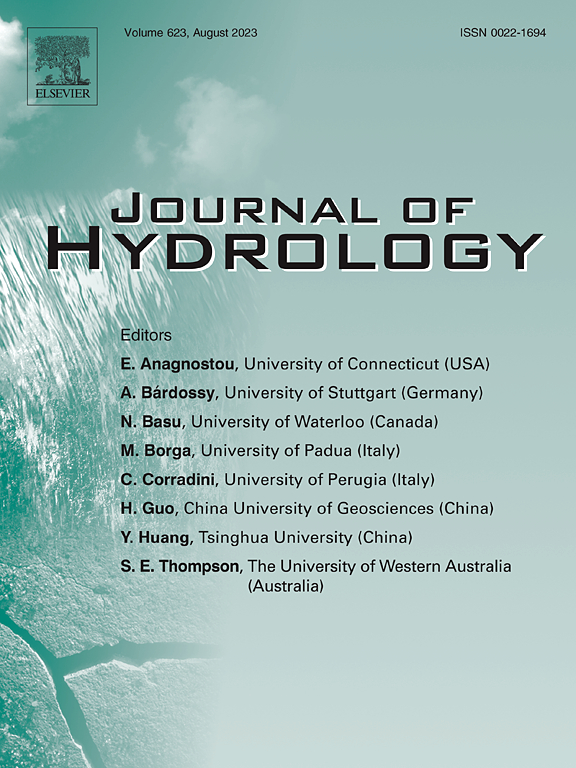Probability analysis of wet and dry encounters in the Yangtze and Yellow River basins under changing environmental conditions
IF 5.9
1区 地球科学
Q1 ENGINEERING, CIVIL
引用次数: 0
Abstract
Assessing the probability of dry-wet runoff encounters under changing environmental conditions provides critical scientific support for sustainable water resource management and watershed security. Therefore, this study enhances the Generalized Additive Model for Location, Scale, and Shape (GAMLSS) through variable reconstruction and error correction, thus proposing an innovative methodology for assessing high-low runoff encounter probabilities in the Yangtze and Yellow River Basins under changing environmental conditions. Atmospheric circulation pattern analysis is further integrated to elucidate mechanisms underlying concurrent low-flow events. Key findings reveal that: (1) The Log-Normal distribution exhibits superior goodness-of-fit for runoff frequency in the Yangtze River’s headwater (source) and downstream regions, while Gamma and Normal distributions emerge as optimal for the upper and middle reaches, respectively. The Inverse Gaussian and Reverse Gumbel distributions demonstrate enhanced performance in the Yellow River Basin. (2) The optimized GAMLSS achieves remarkable accuracy, with empirical–theoretical value deviations constrained between − 0.1 and 0.1, and Nash-Sutcliffe Efficiency (NSE) values ranging from 0.9756 to 0.9966 across basins. (3) Analysis of 1963–2022 data identifies the highest dry-dry encounter probability (23.48 %) in the upper reaches of both basins, followed by headwater (20.89 %) and middle reaches (18.35 %), with the lowest probability (15.37 %) observed in lower reaches. (4) While the Zhimenda-Tangnaihai, Yichang-Toudaoguai, and Datong-Huayuankou combinations show decreasing dry encounter probabilities, the Dajin-Lanzhou combination exhibits a statistically significant upward trend (p < 0.05) in low-flow synchronicity. (5) Concurrent low-flow events in the Yangtze and Yellow Rivers are predominantly linked to two atmospheric circulation patterns: (a) the Lake Baikal high-pressure ridge, and (b) anomalous strengthening of the western Pacific subtropical high. This study advances hydrological extreme event prediction by integrating statistical modeling innovation with climatic mechanism analysis, providing critical insights for adaptive watershed management under global change scenarios.
变化环境条件下长江黄河流域干湿相遇的概率分析
在不断变化的环境条件下,评估干湿径流相遇的概率为可持续水资源管理和流域安全提供了重要的科学支持。因此,本研究通过变量重建和误差修正对广义加性模型(GAMLSS)进行了改进,从而提出了一种评估环境变化条件下长江黄河流域高低径流相遇概率的创新方法。进一步结合大气环流型分析来阐明并发低流事件的机制。结果表明:(1)长江源区和下游径流频率的拟合优度均表现为对数正态分布,而上游和中游径流频率的拟合优度分别表现为Gamma和正态分布。反高斯分布和反甘贝尔分布在黄河流域表现出增强的特征。(2)优化后的GAMLSS精度显著,经验-理论值偏差在- 0.1 ~ 0.1之间,NSE值在0.9756 ~ 0.9966之间。(3)通过对1963-2022年数据的分析,两个流域的干枯相遇概率在上游最高(23.48%),其次是源头(20.89%)和中游(18.35%),下游最低(15.37%)。(4)直门达-唐奈海、宜昌-头道岔和大同-花园口组合的干旱遭遇概率呈下降趋势,而大金-兰州组合的干旱遭遇概率呈显著上升趋势(p <;0.05),低流量同步性。(5)长江和黄河同时发生的低流事件主要与两种大气环流模式有关:(a)贝加尔湖高压脊和(b)西太平洋副热带高压异常增强。本研究将统计建模创新与气候机制分析相结合,推进水文极端事件预测,为全球变化情景下的适应性流域管理提供重要见解。
本文章由计算机程序翻译,如有差异,请以英文原文为准。
求助全文
约1分钟内获得全文
求助全文
来源期刊

Journal of Hydrology
地学-地球科学综合
CiteScore
11.00
自引率
12.50%
发文量
1309
审稿时长
7.5 months
期刊介绍:
The Journal of Hydrology publishes original research papers and comprehensive reviews in all the subfields of the hydrological sciences including water based management and policy issues that impact on economics and society. These comprise, but are not limited to the physical, chemical, biogeochemical, stochastic and systems aspects of surface and groundwater hydrology, hydrometeorology and hydrogeology. Relevant topics incorporating the insights and methodologies of disciplines such as climatology, water resource systems, hydraulics, agrohydrology, geomorphology, soil science, instrumentation and remote sensing, civil and environmental engineering are included. Social science perspectives on hydrological problems such as resource and ecological economics, environmental sociology, psychology and behavioural science, management and policy analysis are also invited. Multi-and interdisciplinary analyses of hydrological problems are within scope. The science published in the Journal of Hydrology is relevant to catchment scales rather than exclusively to a local scale or site.
 求助内容:
求助内容: 应助结果提醒方式:
应助结果提醒方式:


